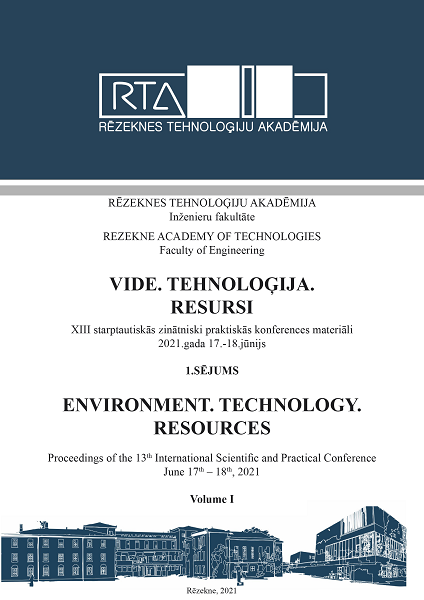DEFORMATION TRANSVERSE SHEAR BENDING STATE OF A THIN PLATE LAYER OF AN ANISOTROPIC GEOLOGICAL MEDIUM FROM THE ACTION OF CONCENTRATED ENERGY IMPULSES
DOI:
https://doi.org/10.17770/etr2021vol1.6510Keywords:
stability of geological environment, radioactive waste, bending of a Reissner-Mindlin plate of medium thickness, finite element methodAbstract
A method is proposed for study the structural stability of the deformation state of structural blocks of the earth's crust, approximated in the form of plate layers of the geological medium when transverse shear bending from the action of concentrated energy impulses. Advances here are carried out in the two directions. First, in contrast to the previous article, the physical and mechanical model of the geological medium is endowed with anisotropic properties, which makes it possible to increase the adequacy of the obtained numerical results to the specifics of the real problem. Secondly, instead of the simplest bilinear 4-node finite elements, the special spectral non-algebraic 8-node finite iso-parametric finite elements are used, the use of which significantly increases both the accuracy of calculations and their reliability in the sense of ensuring the robustness of calculations for relatively small values of the plate thickness. It should be noted that the Finite Element Method uses exclusively only algebraic finite elements (power polynomials in the h-version and orthogonal polynomials in the p-version). It is known from approximation theory that the use of spectral non-algebraic approximations improves the quality of approximations. Therefore, their introduction into the structure of finite element calculations can improve the quality of modeling in the study of the strain-stress-state (SSS) of the geological medium. A structural block (SB) is understood as a plate layer with plan dimensions exceeding the thickness by more than 10 times. The identification of hazardous zones in the rock massive due to stress concentration is complemented by the development of mechanical, mathematical and computational tools for modeling the curvature of the earth's crust during bending based on the classical theory of Kirchhoff and refined Reissner-Mindlin theory. Test calculations have shown that the accuracy of the calculation and the quality of geometric modeling of fragments of an anisotropic geological environment based on the refined 8-node spectral finite element is significantly better than for the 8-node algebraic finite
Downloads
References
Kolesnikov I.Yu., Tatarinov V.N. Stability of the geological environment under the action of bending loads and concentrated energy impulses. GIAB. Mining Information and Analytical Bulletin, 2019 (9): 149-159.
O.C. Zienkiewicz, R.L. Taylor. The Finite Element Method. Vol. 1, 1989; Vol.2, 1991. McGRAW-HILL BOOK COMPANY. London-New-York.
Babenko K.I. Fundamentals of Numerical Analysis. Moscow: Nauka, 1986. 744 p.
Anderson E.B., Belov S.V., Kamnev E.N., Kolesnikov I.Yu., Lobanov N.F., Morozov V.N., Tatarinov V.N. Underground isolation of radioactive waste. Moscow: Gornaya Kniga Publishing House, 2011.592 p.
Kolesnikov I.Yu., Morozov V.N., Tatarinov V.N. Program for calculating the stress-strain state in a rock mass based on heterogeneous finite element modeling “GEODYN 1.0”: Reg. No. 2011614290. 2011.
Kolesnikov I. Yu., Morozov V.N., Tatarinov V.N., Tatarinova T.A. Stress-deformed energy zoning of the geological environment for the placement of ecological infrastructure facilities. Innovatics and Expertise. No. 2 (20), 2017, pp. 77-88.
Tatarinov V.N., Morozov V.V., Kolesnikov I.Yu., Kagan A.I., Tatarinova T.A. Stability of the geological environment as the basis for safe underground isolation of radioactive waste and spent nuclear fuel. Reliability and Safety of Power Engineering. 2014. No. 1 (24), pp. 25-29.
Zhang Y., C. Yang. Recent developments in finite element analysis for laminated composite plates. Composite structures. 2009 (88): 147-157.
Wan D., Hu D., Long T. A linear smoothed quadratic finite element for the analysis of laminated Reissner-Mindlin plates. Composite Structures. 2017 (180): 395-411.
Sprague M., Purkayastha A. Legendre spectral finite element for Reissner-Mindlin plates. Finite Elements in Analysis and Design. 2015 (105): 33-43.
Gorshkov A.G., Kolesnikov I.Yu. Finite Elements Based on the Complete Family of Nonpolynomial Defining Shape Functions for an Arbitrary Number of Boundary Nodes. Izv. RAS. Solid mechanics. No. 1. 1998, pp. 116-129.
Kolesnikov I.Yu. Kirchhoff coordination of field functions in finite elements of Reissner-Mindlin plates by controlling the spectral functions of the shape. Proceedings of the XXI All-Russian Conference "Theoretical Foundations of Designing Numerical Algorithms and Solving Problems of Mathematical Physics" dedicated to the memory of K.I. Babenko. Moscow: Institute of Applied Mathematics, RAS named by M.V. Keldysh, 2016, pp. 43-44.
Kolesnikov I.Yu. Expansions into finite series on complete systems of spectral non-algebraic shape functions and applications. Proceedings of the International Conference "Analytical and numerical methods for solving of hydrodynamics, mathematical physics and biology problems", dedicated to the 100th of KI Babenko (Pushchino, 26–29 August, 2019), Keldysh Institute of Applied Mathematics RAS, 2019, pp. 86-87.
Tseitlin A.I., Glikman B.T. The bending of an elastic rectangular plate with mixed boundary conditions. Trudy TsNII Stroitel’nykh Konstruktsii, Vol. 17, 1971, pp. 123-143.


